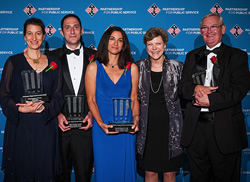Last updated:
2013 News Feature Federal Employee Of The Year Honorees Hail From Nhgri And Nih Clinical Center
Federal Employee of the Year honorees hail from NHGRI and NIH Clinical Center
By Raymond MacDougall
Associate Director of Communications, Division of Intramural Research
 |
In 2011, the team investigated a cluster of infections so severe that it claimed the lives of several severely ill patients enrolled in clinical trials at the NIH Clinical Center, a 243-bed hospital on the main NIH campus in Bethesda, Md. The Partnership for Public Service - which grants the Service to America or "Sammie" medals - awarded them the "Federal Employee of the Year" designation for their dedication and innovation in the face of daunting conditions. White House Chief of Staff Denis McDonough presented the award to the team at an evening ceremony on Oct. 3, 2013.
The NIH team includes Julie Segre, Ph.D., senior investigator in the Genetics and Molecular Biology Branch, NHGRI; Evan Snitkin, Ph.D., postdoctoral fellow in Dr. Segre's laboratory; Tara Palmore, M.D., deputy hospital epidemiologist at the NIH Clinical Center; and David Henderson, M.D., deputy director for clinical care and associate director for quality assurance and hospital epidemiology at the NIH Clinical Center. "Drs. Segre, Snitkin, Palmore and Henderson each applied their respective expertise to work together as a team at a critical time, making an important contribution to establishing safer healthcare settings," said NHGRI Director Eric D. Green, M.D., Ph.D. "Their work effectively demonstrates how genome sequencing technologies can play a central role in battles against antibiotic-resistant microbes."
Bacteria are ubiquitous and prolific, turning out a new generation every hour. Their genetic material, or DNA, can undergo alterations in that process, enabling a subset of the bacteria to survive even after being exposed to antibiotics designed to halt infection. Some defiantly robust bacteria have become even more dangerous due to this resistance, especially for patients with compromised immune systems.
In the summer of 2011, NIH Clinical Center staff first detected carbapenem-resistant Klebsiella pnueumoniae (KPC) harbored by an intensive care unit patient. The bacteria gained the upper hand for a span of months, becoming resistant to almost every form of antibiotic. Tragically, seven patients whose immune systems had been suppressed died from their infections. For more about the efforts to quell the outbreak at the Clinical Center, see http://www.genome.gov/27549852/2012-release-tracking-infectious-outbreaks-by-their-genomes/.
Two of the researchers-Drs. Segre and Snitkin-work in a basic research laboratory, where they study the genomes of microbes. Drs. Palmore and Henderson manage infection control at the NIH Clinical Center. The team seized the opportunity to work together in the midst of the KPC outbreak, adding state-of-the-art genome sequencing and analysis of bacterial DNA to the hospital's rigorous surveillance routines, which are unsurpassed in the country. Through tireless vigilance and ingenuity in tracking the transmission of the bacteria- and with the cooperation of colleagues and care-giving staff-the outbreak was brought under control.
The NIH team gathered their data and documented their experience in a scholarly paper published in Science Translational Medicine in August 2012. The publication has generated an important dialog and intense interest throughout the nation about the problem of antibiotic resistance and transmission of potentially dangerous bacteria in the healthcare setting. Members of the team also have shared their compelling research experience across the country in print and broadcast media interviews and lectures, helping the public understand the challenges that exist in infection control.
The team's use of bacterial genome sequencing proved to be a novel and effective way to trace the precise route of bacterial transmission. The technique also revealed that patients who do not display symptoms may play a role in transmission. The collaboration between the NIH Clinical Center infection control experts and NHGRI genomics researchers ultimately demonstrated that microbial genome sequencing is a formidable tracking tool for hospital surveillance.
"Dr. Snitkin and I are honored to be acknowledged for our work," said Dr. Segre. "The partnership with our courageous collaborators at the NIH Clinical Center was crucial for this achievement." The team has dedicated this award to the patients who died during the outbreak, she said.
The Samuel J. Heyman Service to America Medals pay tribute to America's dedicated federal workforce, highlighting those who have made significant contributions to our country. Honorees are chosen based on their commitment and innovation, as well as the impact of their work on addressing the needs of the nation. To read more about the Sammies, go to: Samuel J. Heyman Service to America Medals (Sammies) Posted: October 17, 2013
